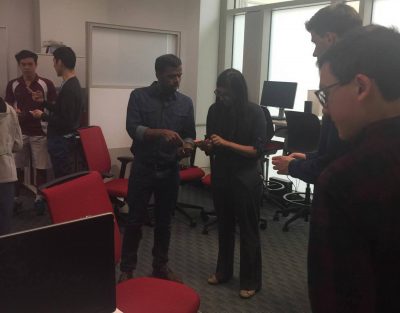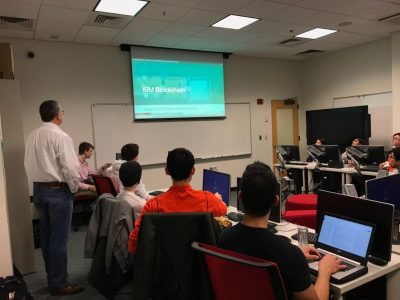 Following his workshop last week on An Introduction to Blockchain, Christopher Day, a representative from RapidQube, held a workshop on Blockchain in Business. Although blockchain was created in 2008, it has recently gained popularity because it is the framework behind Bitcoin. Since Bitcoin, there have been many strides made in an attempt to apply blockchain to different aspects of business. “This week was about teaching students how to apply blockchain based on how the technology is already being used in different disciplines,” said Day following the workshop.
Following his workshop last week on An Introduction to Blockchain, Christopher Day, a representative from RapidQube, held a workshop on Blockchain in Business. Although blockchain was created in 2008, it has recently gained popularity because it is the framework behind Bitcoin. Since Bitcoin, there have been many strides made in an attempt to apply blockchain to different aspects of business. “This week was about teaching students how to apply blockchain based on how the technology is already being used in different disciplines,” said Day following the workshop.
The workshop began with a brief overview from last week, and then Day focused on the benefits the business world could gain by applying blockchain technology. Blockchain could be implemented in shipping, the food industry, insurance, and supply chain, and companies such as Visa, UPS, JP Morgan, Chase, and IBM are all different companies that are already implementing it. Blockchain can store both structured and unstructured data, such as documents or pictures, by simply scanning it and uploading it. When the information is needed there is easy access and every user in the chain will know who uploaded the information. IBM is using it for their global finance settlement work, so they are able to take dispute resolution out of the process because everyone has access to see transactions on the blocks. Shipping companies are using it as a fault-free way to track their products. Insurance companies have begun to use blockchain for car accidents, so you would take a photo after getting into an accident, upload it, and an AI would automatically filter through what is wrong with the car. According to Day, “any place where you have people exchanging information and rules have to be applied you can apply blockchain.”
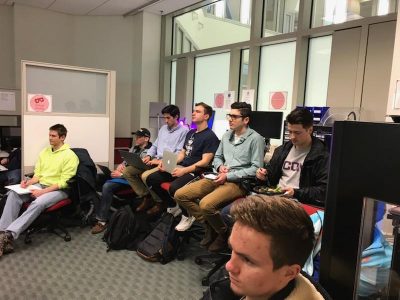
Charles Haylock, a senior studying History and German, went to both the Introduction to Blockchain and Blockchain in Business workshops. “Blockchain is really important and I am thankful and grateful to be a part of a university that recognizes that. From what I’ve heard and what I’ve read there is a heavy demand in the business world telling universities that they need students to know this.” Because of the increasing importance and high demand for knowledge on blockchain, there will be a third workshop on Blockchain Applications in Insurance held on Friday, March 30th in the BUSN Board room, 321. This workshop is a partnership between OPIM Innovate and the newly formed Werth Institute for Entrepreneurship and Innovation. Register ahead of time to secure a seat.
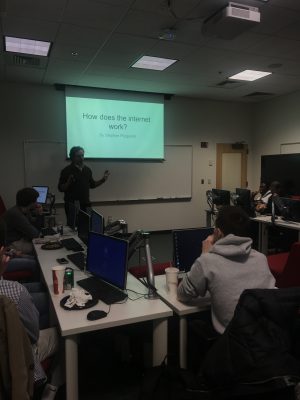 The internet: an everyday tool that has somehow become obscure and mysterious in both its definition and the way it works. On Friday, February 9, Adjunct Professor
The internet: an everyday tool that has somehow become obscure and mysterious in both its definition and the way it works. On Friday, February 9, Adjunct Professor 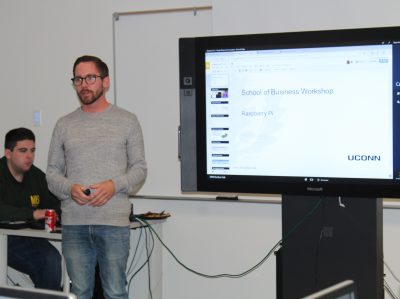 On Friday, December 1, the Operations and Information Management (OPIM) Department held it’s last workshop of the semester on Microcontroller Applications. Microcontrollers are small circuit boards that have the computer power to perform different tasks. There are three common brands of microcontrollers, including Raspberry Pi, Arduinos, and Intel Edisons. Although the OPIM Department has all three types, this workshop used Raspberry Pis to enhance the hands on experience of the activities. So far there have a number of versions of Raspberry Pis manufactured and each version has gotten better over time adding additional hardware and features including wireless and Bluetooth technology. Microcontrollers are so open ended, anyone can benefit from their use.
On Friday, December 1, the Operations and Information Management (OPIM) Department held it’s last workshop of the semester on Microcontroller Applications. Microcontrollers are small circuit boards that have the computer power to perform different tasks. There are three common brands of microcontrollers, including Raspberry Pi, Arduinos, and Intel Edisons. Although the OPIM Department has all three types, this workshop used Raspberry Pis to enhance the hands on experience of the activities. So far there have a number of versions of Raspberry Pis manufactured and each version has gotten better over time adding additional hardware and features including wireless and Bluetooth technology. Microcontrollers are so open ended, anyone can benefit from their use.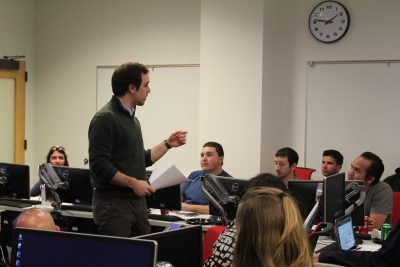 Blockchain is a peer to peer distributed database that records transactions. “Everyone can have a copy of the ledger, the list of all records, and see every transaction. Because everyone has this ability, everyone can check and make sure that the lists are correct,” said Fitzgerald. Each group of transactions gets added to the ledger as a different block, and it becomes a chain because each block builds upon the data from the first block. Although the concept of Blockchain is relatively new, it is not a new technology. Instead, it is a system that uses existing technologies, that wouldn’t normally be combined, in new ways. “It’s sort of a greater than the sum of its parts product” using elements of cryptography, accounting, and math to create the database.
Blockchain is a peer to peer distributed database that records transactions. “Everyone can have a copy of the ledger, the list of all records, and see every transaction. Because everyone has this ability, everyone can check and make sure that the lists are correct,” said Fitzgerald. Each group of transactions gets added to the ledger as a different block, and it becomes a chain because each block builds upon the data from the first block. Although the concept of Blockchain is relatively new, it is not a new technology. Instead, it is a system that uses existing technologies, that wouldn’t normally be combined, in new ways. “It’s sort of a greater than the sum of its parts product” using elements of cryptography, accounting, and math to create the database.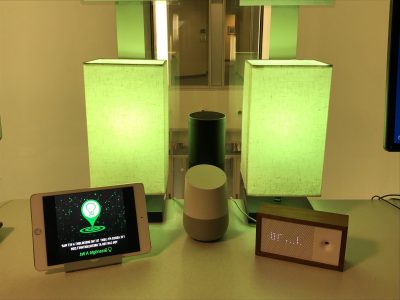 On Friday November 10th, LIFX, a company that creates smart lightbulbs, decided to participate in a movement that began in 2013, Greenlight A Vet. The company states that changing your lights to green is an easy way to establish visual support for America’s veterans by changing lights to green. The color green represents hope and positive well-being and green light is to show forward movement or advancement towards the cause. Once a participant change their lights to a particular color green they will appear on the LIFX greenlight map. The green light map shows where people in the United States have been using the app to change their lights to green. To raise awareness of the campaign, participants are encouraged to share their green light on the map and post on social media. A a user is encouraged to share a photo of the green light using the hashtag #greenlightavet. If not interested in sharing a photo, an alternative way to raise awareness is by applying the Greenlight A Vet filter onto a profile picture on Facebook.
On Friday November 10th, LIFX, a company that creates smart lightbulbs, decided to participate in a movement that began in 2013, Greenlight A Vet. The company states that changing your lights to green is an easy way to establish visual support for America’s veterans by changing lights to green. The color green represents hope and positive well-being and green light is to show forward movement or advancement towards the cause. Once a participant change their lights to a particular color green they will appear on the LIFX greenlight map. The green light map shows where people in the United States have been using the app to change their lights to green. To raise awareness of the campaign, participants are encouraged to share their green light on the map and post on social media. A a user is encouraged to share a photo of the green light using the hashtag #greenlightavet. If not interested in sharing a photo, an alternative way to raise awareness is by applying the Greenlight A Vet filter onto a profile picture on Facebook.
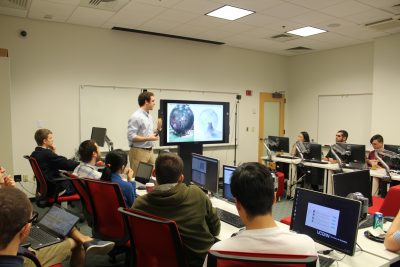 Virtual reality can be run through many different platforms but Professor Fitzgerald focused on the Unity software for the workshop. “The Unity engine is just something that has done all the hard work for you already. So the physics and the calculation of the computer code has all been done for you.” Giving students a background on the Unity engine will help them build confidence to be able to create their own virtual reality experiences.
Virtual reality can be run through many different platforms but Professor Fitzgerald focused on the Unity software for the workshop. “The Unity engine is just something that has done all the hard work for you already. So the physics and the calculation of the computer code has all been done for you.” Giving students a background on the Unity engine will help them build confidence to be able to create their own virtual reality experiences.  Although virtual reality is relatively new, its real world applications are endless. So far, it has been used to train doctors and surgeons, to treat people with anxiety and fears, to improve athletics, to train military personnel, to assist in construction and home design, and even to help paralyzed people walk again. In one instance during the workshop virtual reality was used along with a brain interface machine to restore people’s ability to walk when they were paralyzed. Because of virtual reality, paraplegics were able to have their bodies recreate cells that wouldn’t have otherwise been created in order to get themselves to walk again.
Although virtual reality is relatively new, its real world applications are endless. So far, it has been used to train doctors and surgeons, to treat people with anxiety and fears, to improve athletics, to train military personnel, to assist in construction and home design, and even to help paralyzed people walk again. In one instance during the workshop virtual reality was used along with a brain interface machine to restore people’s ability to walk when they were paralyzed. Because of virtual reality, paraplegics were able to have their bodies recreate cells that wouldn’t have otherwise been created in order to get themselves to walk again.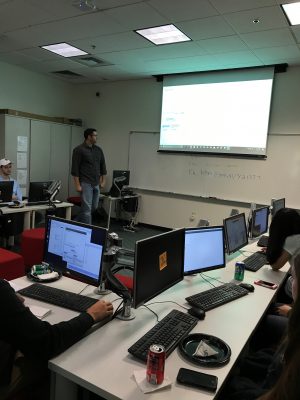 On Friday, October 27, the UConn Operations and Information Management (OPIM) Department conducted a workshop on predictive modeling. This workshop is one of the technology workshops that the department is conducting in order to enhance the OPIM Innovate Initiative.
On Friday, October 27, the UConn Operations and Information Management (OPIM) Department conducted a workshop on predictive modeling. This workshop is one of the technology workshops that the department is conducting in order to enhance the OPIM Innovate Initiative.

